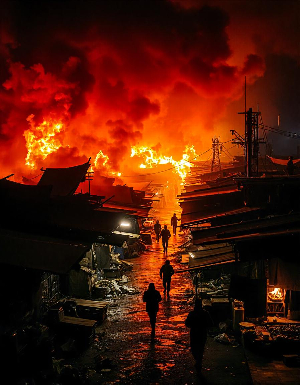TrenderHQ Blog of Thursday, 2 January 2025
Source: Philip NeeWhang
What Truly Caused the Fire at Kantamanto Market, Accra?

The recent fire outbreak at Accra’s Kantamanto Market has left Ghanaians shocked and traders devastated. Known as one of the central hub for commerce and livelihood, the market’s destruction raises critical questions: What truly caused the fire, and how can such disasters be prevented in the future?
As authorities launch investigations, public discourse is rife with speculation and blame. While eyewitnesses recount harrowing experiences, opinions on the fire’s origins remain divided.
The below video link contains some opinions by eyewitnesses and affected traders: What truly caused the fire at Kantamanto Market, Accra Ghana
Speculations and Theories
The cause of the fire has not yet been officially determined, but several possibilities have been floated:1. Electrical Faults: Market fires in Ghana have often been attributed to outdated or faulty electrical wiring. Could a similar issue have sparked the Kantamanto blaze? This raises concerns about regular inspections and maintenance in high-risk areas.
2. Poor Market Infrastructure: Overcrowding, poorly constructed stalls, and inadequate access routes for emergency responders are longstanding challenges in Ghanaian markets. Was the market’s infrastructure equipped to handle such an incident?
3. Trader Practices: Some have questioned whether unsafe storage of flammable materials or negligence in handling cooking appliances could have contributed to the disaster. Are safety protocols clearly defined and followed within the market?
4. Sabotage or Arson: While less common, the possibility of foul play cannot be entirely ruled out. Could internal disputes or external conflicts have played a role?
Emergency Response: Could More Have Been Done?
The response time of emergency services has come under scrutiny. Questions arise about preparedness and resource allocation:- Were fire hydrants in the vicinity functional?
- Was the market accessible to fire trucks?
- Could traders have been better trained in initial fire control measures?
These issues highlight the recurring challenges faced by emergency responders in Ghana’s densely populated markets.
Recurring Market Fires: A Larger Problem?
The Kantamanto fire is not an isolated event. Over the years, major markets like Makola and Kaneshie have faced similar tragedies, often with significant loss of property and livelihoods.- Why do these incidents keep happening?
- Are there systemic gaps in market safety management?
- What long-term measures are being taken to prevent future disasters?
The Need for Accountability and Action
As traders rebuild their lives, the question of accountability remains unanswered. Stakeholders, including market authorities, government agencies, and traders themselves, must address key issues:- Regular inspections and upgrades to market infrastructure.
- Clear enforcement of safety regulations.
- Emergency response training for traders.
Without comprehensive and collaborative efforts, the cycle of market fires and their devastating consequences may continue.
The Road Ahead
While investigations continue, the focus must shift toward actionable solutions. The Kantamanto fire is a stark reminder of the vulnerabilities in Ghana’s markets and the urgent need for reform.Through dialogue, accountability, and sustained effort, the hope is that such tragedies can be prevented in the future. Note: The thumbnail image is a representation of the incident and not an actual photo from the event.














